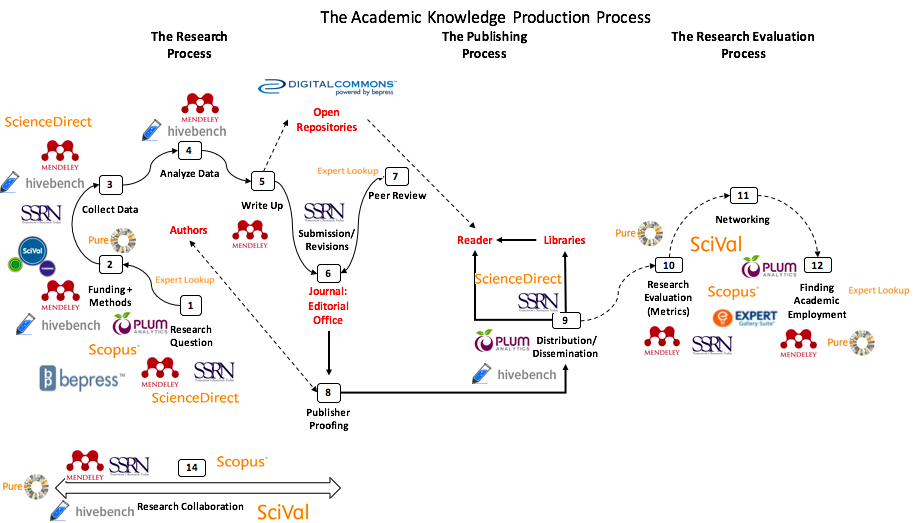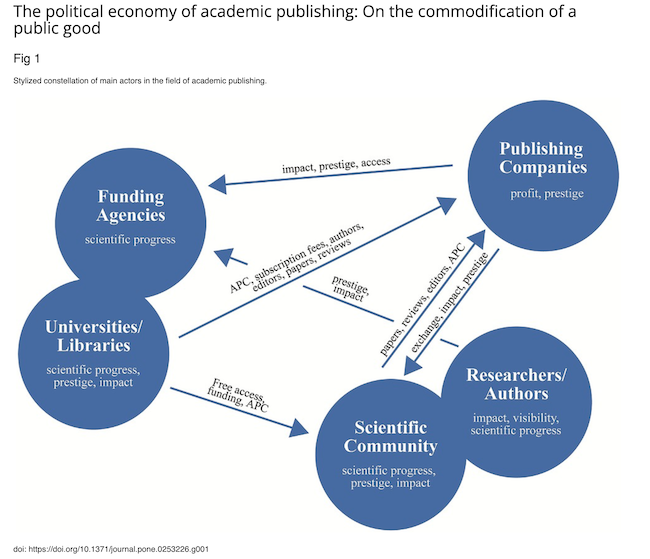(Image: http://clipart-library.com/clipart/249133.htm)
The Origin and the Oligopoly of Academic Publishing
The discourse around Open Access and Open Science can be traced back to the rise of commercial academic publishing in the post-WWII era. The post-war and Cold War periods provided a new turning point and economically viable environments for commercializing academic publishing. They helped to lay the foundation of the commercial system by which the top academic publishers came to monopolize the industry. According to Lariviére et al., in their study of 45 million citation records from the Web of Science covering 1973 to 2013, the publishing output by the top 5 publishers dominates, accounting for more than 50% of all papers published in 2013. Moreover, the same academic publishers enjoyed increased profits “by a factor of almost 6 folds” as they adapted to the digital era, placing them at a level equivalent to the most profitable pharmaceutical, bank, and automobile manufacturing companies.1
“[…T]he scientific journal publishing market faces oligopolistic conditions, where big players such as Elsevier, Springer, Taylor & Francis, Wiley-Blackwell and Wolters Kluwer determine annually increasing subscription rates that make up a considerable amount of research spending […].”2
The Guardian’s 2017 article by Buranyi reports that Elsevier specifically posted profit margins of over 40% in 2012 and 2013. Buranyi traces the commercialization of academic research primarily to Robert Maxwell of Pergamon Press, a precursor to Elsevier.3 The post-war growth and expansion of higher education, with steady investments by national governments and heavy investments in scientific research and technological development, aided the rise of commercial academic publishing. The period consequently helped to establish a lucrative business environment for commercial academic publishers.4 According to Fyfe, learned journals had been printed and distributed with a philanthropical model before Maxwell’s prominent role in commercializing academic publishing.5 The learned societies had been under threat since the late 19th century, experiencing chronic financial difficulty printing and distributing their research for decades. In contrast to the philanthropic model, Maxwell’s new strategies to commercialize academic publishing during the 50s involved selling journals to institutions and international markets. The commercial model brought in by new publishing firms, in effect, taught the learned societies how to publish as a business. However, not all involved in publishing learned journals were enthusiastic; learned societies felt threatened by commercial players. Fyfe quotes David Christie Martin, Executive Secretary of the Royal Society, from 1957, which echoed and predicted the concern that persists to this day regarding the market dominance of the top commercial publishers.
“The commercial houses had another aim in life and their high charges, justified on commercial grounds, might become a danger…”6
The Scientific Publishing Market
The scientific publishing market is not sustainable and yet continuously demands public funds to be fed into their commercial enterprise. Puehringer et al. describe this dire situation by analyzing “power differential and financial flows” in academic publishing. They deconstruct and visualize the market structures of scientific publishing by constructing a schematic four-channel model.7
“
The inside [] added by the author.
- Channel 1: subscription fees, mainly paid by university libraries [to publishers]
- Channel 2: APCs and submission fees, paid either by universities or funding agencies, in rare cases also by researchers themselves [to publishers]
- Channel 3: the provision of reviews and journal editorship free of charge
- Channel 4: the provision of research papers—the main input—free of charge”8
The above diagram shows how public funds heavily subsidize the publishing industry. Puehringers et al. explain that “the incentive structures of the current academic system and the intrinsic motivation of individual researchers and academic institutions [offer] a very lucrative business model for a small number of top academic publishing companies.”9
Platform Capitalism and Open Scholarly Communication
Scholarly communication is subject to platform capitalism. The term “platform capitalism” has been discussed in the context of big tech companies, notably Google, Apple, Facebook and Amazon (GAFA), and their monopolistic power based on “network effects and data-intensive business models.”10
In academia, especially in STEM disciplines, scholarly journals are the primary vehicle for communicating and sharing research results and the means to establish researchers’ reputations and credibility in the fields, linking to the advancement of their careers. The extent of the power in knowledge production by top commercial publishers is much deeper and goes beyond journal publications as the primary vehicle of scholarly communication. As the top profitable publishers rebrand themselves as information and data analytics companies, researchers and institutions became more dependent on their for-profit research products and infrastructures. Posada & Chen, for example, demonstrate how Elsevier has strengthened its entrenchment in the knowledge production processes since 2010.11 Elsevier has been actively acquiring smaller companies that offer new technologies, incorporating them into their platform, and connecting all research and knowledge production processes, presenting their platform as an attractive tool/product for researchers and institutions.

The above diagram represents Elsevier’s academic knowledge production process scheme based on Posada & Chen’s analysis. The following is a list of the acquisitions, indicating the year of acquisition and the information source.
- Pure, a research information and management tool, in 2012. [Elsevier announcement.]
- Mendeley, a reference manager, was acquired in 2013. [Reported by TechCrunch.]
- SSRN, a preprint and publishing community for social sciences and law, in 2016. [Scholarly Kitchen post.]
- hivebench, a laboratory data management tool, in 2016. [Elsevier announcement.]
- Plum Analytics, an altmetric data aggregator, in 2017. [Scholarly Kitchen post.]
- bepress, an institutional repository platform, in 2017. [Elsevier announcement.]
Furthermore, in 2022, Elsevier acquired interfolio, a system that allows researchers and institutions to manage all aspects of research activities, including planning, evaluation and reporting. The all-encompassing nature of the system will further strengthen their grip on the platform and research processes by monitoring the data regarding the use of their platform by researchers and institutions. [Elsevier announcement].
Posada & Chen broke down the academic knowledge production process into three phases in the diagram (research, publishing, and evaluation), showing how Elsevier’s digital scholarly products are spread throughout these phases. The authors thus critically point out that integrating the research production process under Elsevier’s infrastructural scheme gives them the power and control over “the content and methodological approach of the research being produced.”12 Elsevier’s all-encompassing system, in effect, discourages diverse methodologies other than the dominant mainstream scientific method, on top of the barriers to competition and increased marginalization for researchers.
Open Access and the Oligopoly of Academic Publishing
The Open Access (OA) market expands as funders and universities mandate OA publications. The primary revenue source for the OA journal article publishing is based on the author-pay model, called Article Processing Charges (APCs). The five oligopoly publishers (Elsevier, SAGE, Springer-Nature, Taylor and Francis, and Wiley) continue to grow in the OA market, with their global OA revenues estimated at $1.06 billion, according to the detailed study by Butler et al.13 In their investigation, they found that the top five commercial publishers are shifting to open access leveraging the APC business model. They analyzed the datasets of publication outputs by the top publishers between 2015 to 2018. For example, they note that disciplinary categories substantially skew the distribution of APC revenues. The Natural Sciences and the Medical and Health Sciences account for 82.7% of the estimated total APCs revenues by the top publishers.
There are important distinctions between Gold OA and Hybrid OA regarding APC payments. Gold OA refers to “born open” access journals that publish all accepted articles on the publisher’s website with an open license immediately upon APC payments. On the other hand, Hybrid OA refers to established commercial subscription journals for which the publisher offers an option to pay an APC to publish an article as open access. According to the same study by Butler et al., Elsevier, for example, significantly grew its OA articles by 49.9% in Hybrid OA and 43.1% in Gold OA.14 They note that the publishers charge more APCs for Hybrid OA than Gold OA. Furthermore, Solomon & Björk found that publishers demanded higher APC charges for journals with higher Impact Factors.15 Butler et al. also note that most of the journal articles in the Humanities and the Social Sciences pay for Hybrid OA, 89.9% and 85.1%, respectively.16
The OA journals market is already forming an oligopoly. Butler et al. found that four OA journal publishers, BMC, Hindawi, MDPI and Springer Open, dominate the OA market, accounting for approximately two-thirds of the entire OA output. All the OA publishers, except MDPI, are members of the oligopoly publishers. BMC and Springer Open are subsidiaries of their parent company, Springer Nature, and John Wiley & Sons acquired Hindawi in 2021.17 Rodriguez et al. thus argue that the concentration of OA publishing in these four Gold OA publishers is worse than the five oligopoly publishers studied by Lariviére et al. in 2015.18
Many researchers are concerned about economic and prestige barriers in OA publishing.19 The emerging OA publishing market structure is advantageous for the resource-rich researchers in the Global North while being disadvantageous for marginalized researchers, early-career researchers, and those in the Global South. Butler et al. point out that the OA publishing market recreates and reinforces “the Western worldview on academic publishing and reward system at large.” 20 Amarante et al., for example, found that “the bulk of research on the South is conducted by researchers from the North” in their investigation of how Southern researchers in Development Studies are represented in conference presentations, journal articles, and citation records.21 Similarly, Cummings & Hoebink found ten well-established journals in Development Studies show “a strong Western dominance in terms of the ownership of the journals, the nationality of the authors, and the international diversity of their editorial boards”.22
The APC business model has been criticized because it sustains and recreates structural inequality in research publishing. For example, using the Web of Science database, Demeter & Istratii investigated the relationships between high APC charges and high Impact Factor (IF) journal titles in three disciplines: Area Studies, Anthropology, and Computer Science publications. Their target was Development Studies but used Area Studies and Anthropology, instead, as the closest disciplinary categories available in the Web of Science scheme. They hypothesized the positive correlations between high IF titles and high APC charges considering the Global North hegemony of the selected study areas. The results showed significant positive correlations in Area Studies and Anthropology, but not Computer Science.23 Demeter & Istratii found that high-ranking Computer Science journal titles are published by international associations such as the Institute of Electrical and Electronic Engineers (IEEE) and the Association for Computing Machinery (ACM), which have lower APC in comparison. On the other hand, there are no similar associations publishing journals in Area Studies and Anthropology. They found the APCs for the Gold OA journals in Area Studies and Anthropology are 20-30% higher than those in Computer Science.24 Demeter & Istratii thus point out that the overall implication of the APC business model would further exacerbate the global divide.
“[I]n subject areas that are dominated by Northern publishers, the level of APCs charged and IF [impact factor] will move together, which combined with the existing economic inequalities among countries, are anticipated to grow the disparities between Northern and Southern researchers.”25
The 2022 scoping review on Open Science regarding “cumulative advantages and threats to equity” by Russ-Hellauer et al. also highlights the persistent multi-level inequity in scholarly communication, which raises significant issues in the transition to Open Access and Open Science. Their scoping review of the literature also highlights the dominant neoliberal economic forces exacerbating global inequities in knowledge production. The prevailing neoliberal climate advances “market principles of competition, foregrounding its economic role in training the workforce and fostering new products and services, at the expense of the social mission to provide upward mobility for marginalized populations.”26
Next: Libraries and the Oligopoly of Academic Publishing
Sources:
1. Larivière, Vincent, Stefanie Haustein, and Philippe Mongeon. “The Oligopoly of Academic Publishers in the Digital Era.” PLOS ONE 10, no. 6 (June 10, 2015): e0127502. https://doi.org/10.1371/journal.pone.0127502(page 10).
2. Larivière et al., 11.
3. Buranyi, Stephen. “Is the Staggeringly Profitable Business of Scientific Publishing Bad for Science?” The Guardian, June 27, 2017, sec. Science. https://www.theguardian.com/science/2017/jun/27/profitable-business-scientific-publishing-bad-for-science.
4. Archives, The National. “Before and after the Second World War.” The National Archives, Kew, Surrey TW9 4DU. Accessed November 1, 2022. https://www.nationalarchives.gov.uk/cabinetpapers/themes/before-after-second-world-war.htm
Brewis, Georgina, Sarah Hellawell, and Daniel Laqua. “Rebuilding the Universities after the Great War: Ex-Service Students, Scholarships and the Reconstruction of Student Life in England.” History 105, no. 364 (2020): 82–106. https://doi.org/10.1111/1468-229X.12926.
Friedberg, Aaron L. “Science, the Cold War, and the American State.” Edited by Harvey M. Sapolsky, Stuart W. Leslie, and Robert A. Divine. Diplomatic History 20, no. 1 (1996): 107–18.
Graham, Hugh Davis. The Rise of American Research Universities: Elites and Challengers in the Postwar Era. Johns Hopkins University Press, 1997.
Roger L Geiger author. American Higher Education since World War II: A History. Princeton University Press, 2019. http://lib-e2.lib.ttu.edu/login?url=https://www.jstor.org/stable/10.2307/j.ctv9hvtbz.
5. Why Academics Publish (The Way That They Do)? | Professor Aileen Fyfe, Inaugural Lecture, 2021. https://www.youtube.com/watch?v=sKR4NgshTIs In this presentation, Prof. Fyfe traces the history of scholarly communication and how it developed into a commercial enterprise after the post-WWII period is significant.
Fyfe, Aileen, Kelly Coate, Stephen Curry, Stuart Lawson, Noah Moxham, and Camilla Mørk Røstvik. “Untangling Academic Publishing: A History of the Relationship between Commercial Interests, Academic Prestige and the Circulation of Research.” Zenodo, May 25, 2017. https://doi.org/10.5281/zenodo.546100
6. Professor Aileen Fyfe, Inaugural Lecture 2021, Slide, 54:31.
7. Puehringer, Stephan, Johanna Rath, and Teresa Griesebner. “The Political Economy of Academic Publishing: On the Commodification of a Public Good.” PLOS ONE 16, no. 6 (June 17, 2021): e0253226. https://doi.org/10.1371/journal.pone.0253226
8. Puehringer et al., 6.
9. Puehringer et al., 6.
10. Narayan, Devika. “Platform Capitalism and Cloud Infrastructure: Theorizing a Hyper-Scalable Computing Regime.” Environment and Planning A: Economy and Space 54, no. 5 (August 1, 2022): 911–29. https://doi.org/10.1177/0308518X221094028, p. 911.
11. Posada, Alejandro, and George Chen. “Inequality in Knowledge Production: The Integration of Academic Infrastructure by Big Publishers.” In ELPUB 2018, edited by Leslie Chan and Pierre Mounier, Vol. Connecting the Knowledge Commons: From Projects to Sustainable Infrastructure. Toronto, Canada: Association Francophone d’Interaction Homme-Machine (AFIHM), 2018. https://doi.org/10.4000/proceedings.elpub.2018.30.
12. Posada and Chen, para 13.
13. Butler, Leigh-Ann, Lisa Matthias, Marc-André Simard, Philippe Mongeon, and Stefanie Haustein. “The Oligopoly’s Shift to Open Access. How For-Profit Publishers Benefit from Article Processing Charges.” Zenodo, September 7, 2022. https://doi.org/10.5281/zenodo.7057144.
14. Butler et al., 25.
15. Solomon, David J., and Bo-Christer Björk. “A Study of Open Access Journals Using Article Processing Charges.” Journal of the American Society for Information Science and Technology 63, no. 8 (2012): 1485–95. https://doi.org/10.1002/asi.22673.
16. Butler, et al., 21.
17. Butler, et al., 6.
18. Rodrigues, R. S., Abadal, E., & de Araújo, B. K. H. (2020). Open access publishers: The new
players. PLOS ONE, 15(6), e0233432. https://doi.org/10.1371/journal.pone.0233432
19. Demeter, Márton, and Ronina Istratii. “Scrutinising What Open Access Journals Mean for Global Inequalities.” Publishing Research Quarterly 36, no. 4 (December 1, 2020): 505–22. https://doi.org/10.1007/s12109-020-09771-9 , p. 506.
See also:
Larivière et al., 24.
Albornoz, Denisse, Maggie Huang, Issra Marie Martin, Maria Mateus, Aicha Yasmine Touré, and Leslie Chan. “Framing Power: Tracing Key Discourses in Open Science Policies.” In ELPUB 2018, edited by Leslie Chan and Pierre Mounier, Vol. Connecting the Knowledge Commons: From Projects to Sustainable Infrastructure. Toronto, Canada: Association Francophone d’Interaction Homme-Machine (AFIHM), 2018. https://elpub.episciences.org/4612/pdf
Czerniewicz, Laura. “Confronting Inequitable Power Dynamics of Global Knowledge Production and Exchange – Opinion.” Water Wheel 14, no. 5 (September 2015): 26–28. https://journals.co.za/doi/10.10520/EJC176212
Kwon, Diana. “Open-Access Publishing Fees Deter Researchers in the Global South.” Nature, February 16, 2022. https://doi.org/10.1038/d41586-022-00342-w .
RealKM. “Disadvantages in Preparing and Publishing Scientific Papers Caused by the Dominance of the English Language in Science: The Case of Colombian Researchers in Biological Sciences [Top 100 Research & Commentary of 2020].” Accessed November 4, 2022. https://realkm.com/2021/04/20/disadvantages-in-preparing-and-publishing-scientific-papers-caused-by-the-dominance-of-the-english-language-in-science-the-case-of-colombian-researchers-in-biological-sciences-top-100-research-com/.
Thomas W. Crowther, and Jeffrey A. Harvey. “Gold Open Access Publishing in Mega-Journals: Developing Countries Pay the Price of Western Premium Academic Output.” Journal of Scholarly Publishing 49, no. 1 (October 2017): 89–102. https://doi.org/10.3138/jsp.49.1.89.
Okune, Angela, Rebecca Hillyer, Leslie Chan, Denisse Albornoz, and Alejandro Posada. “Whose Infrastructure? Towards Inclusive and Collaborative Knowledge Infrastructures in Open Science.” In Connecting the Knowledge Commons — From Projects to Sustainable Infrastructure : The 22nd International Conference on Electronic Publishing – Revised Selected Papers, edited by Pierre Mounier. Laboratoire d’idées. Marseille: OpenEdition Press, 2019. http://books.openedition.org/oep/9072. This book argues for a plurality of knowledge production. It highlights the diversity in regional, cultural, political and epistemological differences that affect shaping and developing collaboratory infrastructures for Open Science.
Siegel, Jaclyn A., Rachel M. Calogero, Asia A. Eaton, and Tomi-Ann Roberts. “Identifying Gaps and Building Bridges Between Feminist Psychology and Open Science.” Psychology of Women Quarterly 45, no. 4 (December 1, 2021): 407–11. https://doi.org/10.1177/03616843211044494. Addresses exclusion of women’s voices in Open Science. The special issue provides an overview of the feminist perspective on Open Science.
Siriwardhana, Chesmal. “Promotion and Reporting of Research from Resource-Limited Settings.” Infectious Diseases: Research and Treatment 8 (January 1, 2015): IDRT.S16195. https://doi.org/10.4137/IDRT.S16195.
20. Butler et al., 24.
21. Amarante, Verónica, Ronelle Burger, Grieve Chelwa, John Cockburn, Ana Kassouf, Andrew McKay, and Julieta Zurbrigg. “Underrepresentation of Developing Country Researchers in Development Research.” Applied Economics Letters 29, no. 17 (October 7, 2022): 1659–64. https://doi.org/10.1080/13504851.2021.1965528.
22. Demeter and Istratti, 507.
23. Demeter and Istratti, 522.
24. Demeter and Isratti, 519.
25. Demeter and istratti, 520.
26. Ross-Hellauer, Tony, Stefan Reichmann, Nicki Lisa Cole, Angela Fessl, Thomas Klebel, and Nancy Pontika. “Dynamics of Cumulative Advantage and Threats to Equity in Open Science: A Scoping Review.” Royal Society Open Science 9, no. 1 (n.d.): 211032. https://doi.org/10.1098/rsos.211032.
See also: Ross-Hellauer, Tony. “Open Science, Done Wrong, Will Compound Inequities.” Nature 603, no. 7901 (March 14, 2022): 363–363. https://www.nature.com/articles/d41586-022-00724-0.


